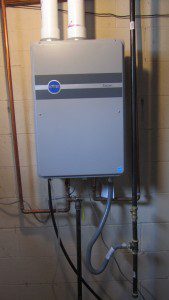In continuing with our technology theme for the month, we decided to focus today’s post on something that, though it isn’t housed directly in the bathroom, directly affects it: the water heater. Tankless water heaters are nothing new, but an item we feel definitely underrated when it comes to technological advances. We asked Dr. Steven Hausman, a 31 year scientist and senior executive who currently speaks on current and emerging technologies for his take on water heaters and his personal story of making the switch.
Close to the beginning of the last century people began to get used to having a constant supply hot water available in their homes whenever they turned on the tap. In the United States the appliance that produces the hot water is of course called a storage water heater. It consists of a cylindrical container ranging from 20 to 100 gallons in size that is heated by electricity, natural gas, propane, heating oil or even solar energy.
Storage water heaters have the advantage of using energy at a relatively slow rate in order to produce a readily available supply of hot water. Unfortunately, the temperature of the water in the tank continually decreases (insulation is far from perfect) causing the heating system to repeatedly cycle to maintain the water temperature at the desired level. In addition, once the hot water supply has been used up (which can happen very quickly if you have family members taking showers, using the dishwasher and/or washing clothes simultaneously) it may take a considerable amount of time for the hot water supply to become available once more. There can also be problems in maintaining a sufficient supply of hot water if a heating element burns out in a system where electricity is used, if scale collects in the bottom of the storage tank and prevents the gas flame from heating the water fast enough because of an insulating effect, if the tank springs a leak or if one of the internal components like the dip tube deteriorates.
When the latter event occurred with my own 15 year old system I decided that it was time to implement some of the advancements that have occurred in technology in the past few years by installing a tankless hot water system. Tankless hot water systems instantly heat the water as it is needed and do not store any water except for what is contained in the heat exchanger coil. Multiple small tankless units can be installed in a house near the outlet, but this entails having to have a power source (easy with electricity, relatively difficult with natural gas) close to each unit and is costly when there are many units needed. Instead I had my old hot water tank removed and installed a single large (199,000 BTU) high efficiency energy factor Rinnai tankless system capable of providing continuous hot water for four showerheads or faucets simultaneously. In addition, because of the need to run the faucet for a considerable length of time before getting hot water when the outlet is a long distance from the hot water source, I also installed a pump that internally circulates the water in the pipes until it is hot enough at the tap. Bottom line, no water down the drain while you are waiting for it to heat up. The temperature (98 – 140 degrees F) of the water can also be wirelessly remotely controlled from several locations in the house.
Contributed by: Steven Hausman

